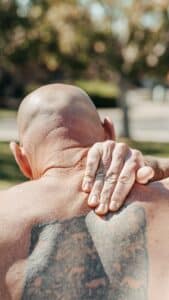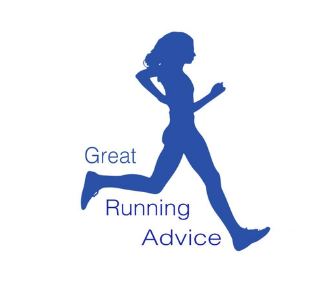Many people suffer from back pain for many reasons, but some runners get upper back pain when running. Runners want to know why they get upper back pain while running. Firstly I will explain what upper back pain is, and I will look at the causes of upper back pain.
What is Upper Back Pain
Upper back pain (and middle back pain) occurs anywhere from the base of your neck to the bottom of your rib cage. Your upper and middle back is called the thoracic spine. Your upper back also has disks that separate each vertebra. These disks absorb shock as you move. There are also many muscles and ligaments in your upper back that hold your spine together.
Causes Of Upper Back Pain
There are many causes of upper back pain. The following are the main reasons for upper back pain:
- Poor posture
- Whiplash or another neck injury
- Lifting improperly
- Muscle Overuse
- Repetitive movements
- Contact sports
- Wearing an overloaded backpack
Poor Posture
This is one of the leading causes of upper back pain. Slouching in a chair over a desk may cause a loss of strength in the muscles. Over time, the weakening of muscles may lead to pain in the area as they experience strains or irritation. When a person slouches, pressure from gravity and the body itself pushes on the spine, neck, discs, and ligaments. Over time, this pressure can lead to pain and other complications.
Whiplash Or Other Neck Injury
Whiplash may cause upper back pain because the forceful snapping motion of your head can injure, irritate, and inflame the muscles around your spine. Due to whiplash, the upper back and shoulder muscles may feel tight and ache persistently.
Lifting Improperly
This may cause upper back pain if we don’t use the proper technique when lifting and lifting with our back rather than our legs. When we do this, we are in danger of straining muscles and tendons in our back, causing upper back pain.
Muscle Overuse
Overusing the upper back muscles through more work than usual, such as spending a day helping a friend move house or painting a ceiling, could cause muscle strains, ligament sprains, and inflammation in the upper back. After spending a day at one of these, how often have you woken up crippled with your back the following day?
Repetitive Movements
Repetitive movements, such as those from physical labor, can lead to muscle and ligament injuries, especially among plasterers, plumbers, and electricians.
Contact Sports
Contact sports can cause upper back pain. This most commonly happens due to an impact while playing American football and rugby.
Wearing An Overloaded Backpack
An overloaded backpack will put undue pressure on our backs when walking, causing upper back pain. For one, when I am on holiday and have even a light backpack on my back for many hours, I will end up with upper back pain as I am not used to carrying around a backpack on my back.
Why Do You Get Upper Back Pain When Running?
Many Runners suffer from upper back pain when running. This is a result of the following.
Incorrect Running Form
Running Long Distance Without Adequate Training
Due to the other causes listed above
Incorrect Running Form
Incorrect running form causes many issues, including upper back pain. The incorrect running form generally happens due to poor posture in our normal day-to-day lives. If we think about how often we stand straight and tall during the day versus how long we are slouched. We are slouched sitting down in front of the computer, slouched driving the car, slouched over the kitchen sink, and slouched checking our phones between texting and scrolling various apps.
If we run with incorrect form, our shoulders raise and tense toward our neck; for example, it can be painful after a long run. We may also be swinging your arms too much or too little. Good running form is essential to prevent upper back pain when running.
Running Long Distances Without Adequate Training
Like anything in life, we need to practice before we can master anything new. The same applies to running. If you just started running today, you will not be able to go out and run a marathon or a half marathon, as we need to build up our mileage slowly. We shouldn’t; increase our weekly mileage by more than 10% weekly. If we go out and run a long distance without building up our mileage slowly, our body will get fatigued during the run, causing our body to lose its running technique. We start to slouch as we run, resulting in the head leaning forward on the neck, causing strain to the upper back and leading to pain.
Good posture, especially while running, is essential to managing neck and back pain.
How To Prevent Upper Back Pain When Running?
There are a few things that we can do as a runner to prevent upper back pain while running,
Correct Running Form
Improve Your Posture
Improve thoracic Mobility
Look at arm Swing while running
Trapezius strengthening.
Correct Running Form
Correcting our running form should relieve the pain in our upper back as we run. When correcting our running form, we need to look at the following:
- Relaxing Our Shoulders
- Slight Lean
- Correct Arm Movements
- Stand Up Tall
- Cadence
Improve Your Posture
Running without suffering upper back pain is hard if our posture is not right. We must have the correct posture when standing, sitting, driving, and sleeping. By trying to practice the following in our daily life, it should help relieve upper back pain when running;
Correct Posture When Standing
- Stand up straight and tall.
- Keep your shoulders back.
- Pull your stomach in.
- Put your weight mostly on the balls of your feet.
- Keep your head level.
- Let your arms hang down naturally at your sides.
- Keep your feet about shoulder-width apart.
Correct Posture When Sitting
- Sit with a straight back
- Get up and walk around every 45 minutes
- Don’t cross your legs
- Keep feet flat on the ground
- Switch positions often
- Relax your shoulders
- Keep elbows close to the body
- Ankles should be parallel to your knees
- Look forward without straining your neck
Correct Posture While Driving
- Sit with your tailbone as close to the back of the seat as possible.
- Sit with your hips so that the seat entirely supports your legs’ backs and your knees are slightly lower than your hips.
- Ensure the seat is at the right height, so your eye line is at least 3 inches above the steering wheel and adequate clearance between your head and the car roof.
- The seat should be set leaning back slightly at between 100 and 110 degrees, not the perpendicular 90 degrees.
- Set the headrest so that it supports your head. Your head should touch it when sitting comfortably.
- Take breaks when driving long distances.
Correct Posture While Sleeping
- Use a mattress with good support.
- Ensure your pillow is the correct height so that your body alignment is correct when you lie down
- Tyr and keep ears, shoulders, and hips in one straight line no matter what position you sleep in.
Improve Thoracic Mobility
Firstly, I will explain what Thoracic Mobility is. The thoracic spine is the middle section of your vertebra between your neck and lower back and composes of 12 thoracic vertebras and your rib cage. Thoracic mobility is the movement of this portion of the spine, which is essential for maintaining good posture.
We can improve thoracic mobility with a series of exercises, as shown in the following video.
Look At Arm Swing While Running.
Correct arm swing when running is very important, as the incorrect swing can contribute to upper back pain.
We should try to do the following:
- Keep your arms bent at a 90-degree angle
- Don’t let your arms swing across your body
- Swing your arms backward, not outwards
- Swing your arms from shoulders, not elbows
- Relax your hands
Trapezius Strengthening
A weak trapezius is another cause of upper back pain.
The trapezius muscle is a large superficial back muscle that resembles a trapezoid. It extends from the external protuberance of the occipital bone to the lower thoracic vertebrae and laterally to the spine of the scapula. The trapezius has upper, middle, and lower groups of fibers.
If we strain this muscle, we generally feel mild or severe pain in the neck, upper back, or shoulders.
If this muscle is weak, we should do the following strengthening exercises:
- Deadlift
- Shrugs
- Barbell Row
- Reverse dumbell flyes
- Pull up
- Lat pulldown
If we perform these exercises, we will make our trapezium muscles much stronger, which should help us when we run.
Final Thoughts
I hope you have a much greater understanding of upper back pain when you are running. It is possible to be caused by running, but more than likely, this pain is due to our everyday life. Most people have poor posture at various times. Poor posture is one of the main reasons for this pain. A poor running form will cause this pain as we run, especially the longer we run.

